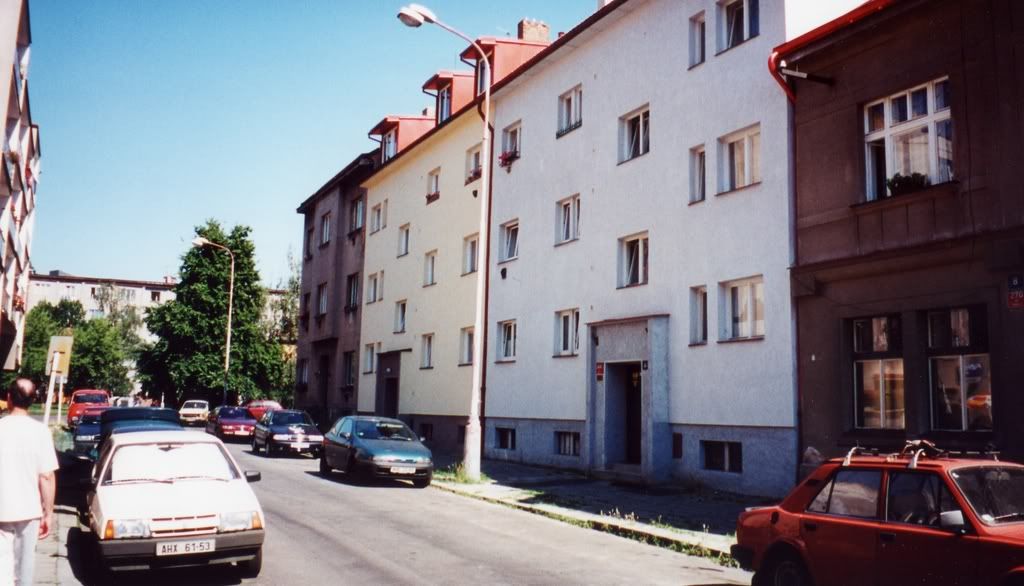Urban Design Today
Ablarc, what form would this approach to urban design take here today? What is the contemporary equivalent? How would it accommodate the car? Or would it?
Ha! briv, you're a prisoner of Zeitgeist theory!
And why not? I gather you're an architect, and most architects are prisoners of Zeitgeist theory. It's drilled into their heads on Day One of architecture school by walking-zombie professors. These guys have only one style to sell --Modernism-- ever since they were brainwashed into ignoring the others.
"Look!" they pitch, "it's Modern Times! There's a new
technology and it dictates a new style for us new and different people."
Actually, it's the style they're selling, and that tail wags a dog --including the technology --which in any case was around when Stanford White put it to different (and probably better) stylistic use. The groined vaults of Penn Station were stucco over mesh lath suspended from steel structure --just as they would be today.
I make a living dressing standardized pre-engineered steel frames in designer duds of the client's choice. Would you care for something in a Mediterranean, sir? Or would your committee prefer Colonial? We have a very nice contemporary line (but not too contemporary, of course). Or can I show you something a little in the style of Wright?
It's not architecture, it's styling. As Krier says, "It doesn't matter what you do in the suburbs. Everything is junk."
Where I live there are only suburbs, so I do junk. Philip Johnson, who brought Modernism to America as an ideologue and later had the veil fall from his eyes, referred to it as "whoring."
Nothing in the technology dictates the style.
Except if you say so. And if you say so, perhaps you have an axe to grind.
If it's not the technology, maybe
people have changed. "Look!" barked the Modernists, "it's Modern Times! There's a new man out there --straightforward, unpretentious and honorable. He has simple needs and plain taste and he looks like Gary Cooper. He works in a factory and he's the wave of the future. We have to design for him!"
But he moved to Mexico.
All that's left is plutocrats and the bushwah. And they both want something a little fancier, thank you. Hard to do when you're sworn to sackcloth: no fancy stitching, flaps or buttons. Well, maybe you can twist and turn your building till ... wait, I'm getting it ! ... the building's
whole shape is fancy!
Nothing in the year on the calendar dictates the style either. Whatever style you work in will be seen eventually as "of its time" by historians who inevitably have perspective --after the razzing from the hecklers has died down. The heckler-in-chief today, the most ardent defender of the current, the entrenched --and the now quite ancient-- academic style, called Modernism: Norman Foster. Read what he has to say about Quinlan Terry.
So here you are, briv, handcuffed, in shackles, head full of Zeitgeist, and chained to you bedpost. Your profs have prepared a nice gag for your mouth, and they are preparing to sit on your face.
Seriously, Modernism is a consciously-chosen style, not a historical inevitability, but if that's all you've been taught, then that's all you can do --unless you take the trouble to teach yourself.
So Modernism has to justify its miserly offerings with a claim of historical inevitability because it's the only sales pitch with any traction with a largely clueless public --still doubtful after all these years. Why? They look around them, and the places they really like are over a hundred years old.
Ablarc, what form would this approach to urban design take here today? What is the contemporary equivalent?
The Modernist approach to urban design was straightforward: they simply substituted
suburban design.
To throw people off the scent they called it "city planning."
They turned the built environment inside out; they said space is not between buildings, it surrounds them on all sides. Thus were born setbacks and buffers, now enshrined in zoning laws.
This made the buildings appear more sculptural, since you could now see all four sides of them in the round, instead of just the one side that faced (fa?aded?) the street.
It also put more
space between buildings, which the Modernists said should be
green. This was an easy sell because it dovetailed with people's desire to own a house in the country like the fat cats --and besides everyone knew that being around chlorophyll improved people's morals and outlook. Ebenezer Howard had said this in his popular and idealistic book,
Garden Cities of Tomorrow. Friedrich Engels and other do-gooders signed on, and the the theory was tested at Bournemouth, Letchworth, Cabrini
Green, Pruitt Igoe and Columbia Point.
Separating buildings meant you had to walk further to get from one place to another. And anyway the walk got a little boring after you'd seen the same tree gazillion times. There wasn't much happening on the paths of Utopia (well, anyway, not stuff you really wanted to have happen).
So from the get-go they came up with a brilliant solution: we'll put everyone in
vehicles to get from one place to another. At first the vehicles were streetcars, but then they were cars. This dovetailed perfectly with Henry Ford's plans, and General Motors bought up the transit systems and took out the streetcars. Since they had to put the cars somewhere, the gardens of Garden City morphed into parking lots. Then the law required these in most places from the start.
So space as unifier had become space as separator.
The suburb is all about territorial rights. You stake your claim and you defend it forever against threat and encroachment from without. When you live in Utopia, you don't want it to change. Not In My Back Yard. In Suburbia, we are all frontiersmen and hermits, and we live in bunkers.
You know how hard it is to change a bunker.
Ablarc, what form would this approach to urban design take here today? What is the contemporary equivalent?
"This approach": I assume you mean the stuff in the photos I posted, the stuff that lives like the North or South Ends or the Back Bay or Beacon Hill.
Nothing has changed, briv, you just build it.
In Boston, you don't even have to change many laws. You do have to change mindsets (what the public theorizes vs. what it observes) and back-scratching procedures (assembling large parcels gives us developers a competitive edge and even a nice FAR bonus from the BRA).
Mostly you have to change the mindset of architects, mired in Zeitgeist theory: "We like Beacon Hill; people like Beacon Hill; they pay a fortune to live there; it's substantially buildable pretty much exactly as is (give or take a few building code provisions); but
it would be IMMORAL to emulate it directly because it would not be true to our times.
The Zeitgeist.
So let's set aside the accumulated wisdom and know-how of millennia and agonize around for a century or two to see if we can come up with something different that is at best a distant paraphrase of what we like. The iron law of History, says, you see, that we can no longer have what we like, because the fact that it was done in the past means it can no longer be done in the future. It would be immoral. Plagiaristic. Uncreative.
Think what they would say.
What they would say in the future: "Thank you."
What historians would say: "this is how they built at that time."
What future architects would say: "We returned to sanity and competence after wandering in the woods for a century."
What architects will say this minute if you try it: "You can't do that, it's immoral. Why, it's 2008!"
It's still the Age of Muddlehead.
It's 2008, it's a new millennium; should we perhaps switch to square wheels on our cars to commemorate the changing times? It might, after all, be immoral to keep on rolling on round wheels --so unoriginal-- exactly as though this were still the 20th Century!
In city planning, we tried a century of square wheels. It's time to leave that behind as a failed experiment and get back to the future.
And to think that 90% of what you see in #2 was built since 1950's...
This is true. How much of Munich do you think was left after the War? They just ignored Corbu and the other Twentieth Century theoreticians and did it right. They knew it was right because they had eyes to see and memories to remember --and their judgment wasn't clouded by theories that said right is different at different times. Will the day come when --just to be modern and different-- we dabble in child molesting?
Boston up until the 1950's had this kind of density.
That's right, and the theoreticians took it away. They gave us the new West End.
Ablarc, what form would this approach to urban design take here today? What is the contemporary equivalent? How would it accommodate the car? Or would it?
All three cities I posted are populated mostly by prosperous people who own cars. There are no parking lots where buildings used to stand, though there are parking garages galore, many of them underground.
Before the War, all three of these cities made do with the streetcar because most folks had no cars. Speedy transit wasn't needed to compete.
After the War, when folks began to buy cars, all three cities built subway systems to compete. They didn't tear down buildings to provide convenient parking. They improved the city, they didn't wreck it.
But why even ask? Just look at the pictures. Where's the mystery?
Oh ... it's in the Zeitgeist.
It can't be that simple.
This is Modern Times.
We have to put on our handcuffs before we start to design.





















































